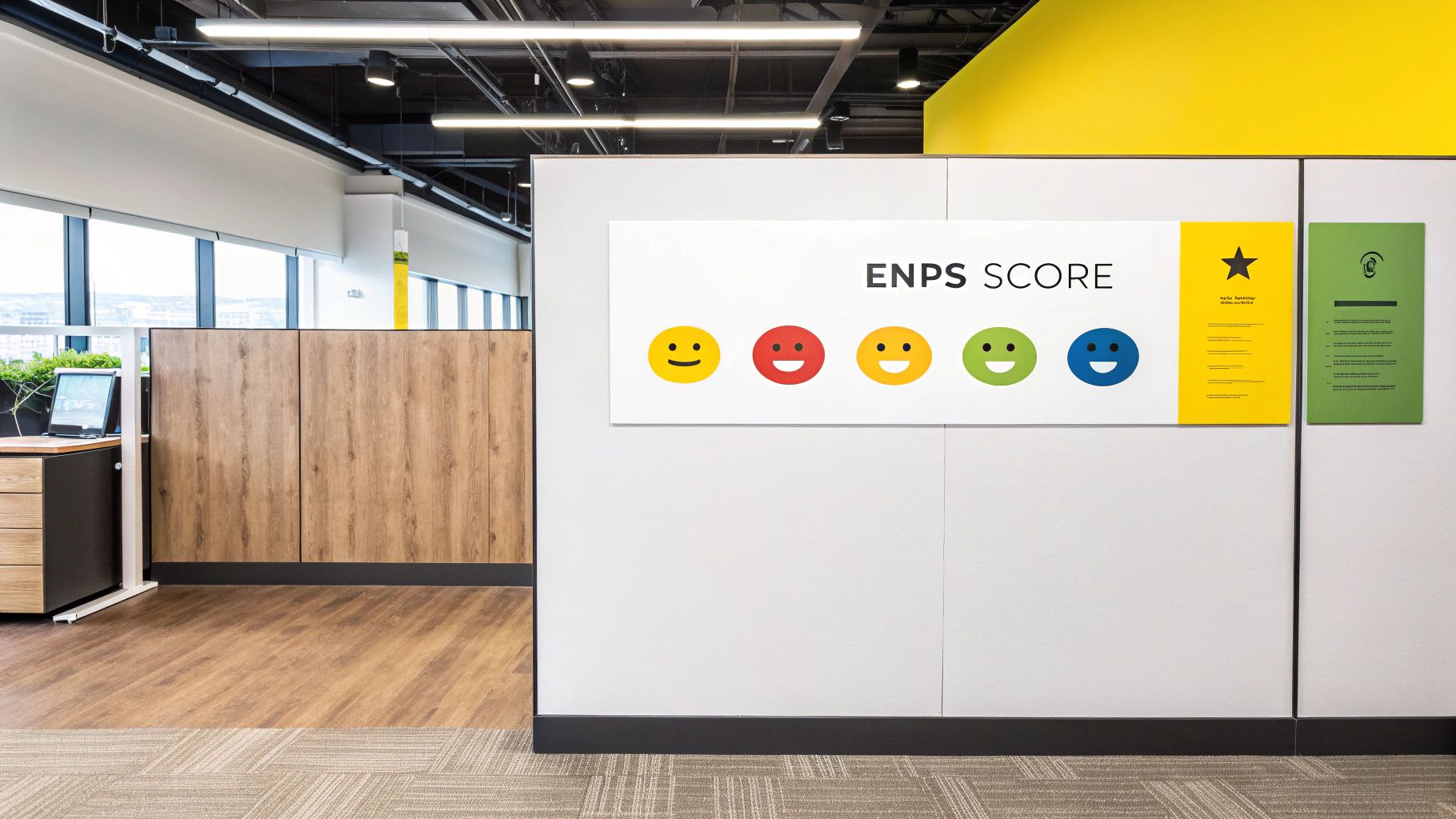In fast-paced, agile environments, relying on a 'gut feeling' about team morale is a risky strategy. Disengagement acts as a silent productivity killer, directly contributing to higher turnover, missed deadlines, and a noticeable decline in innovation. To build and sustain resilient, high-performing teams, leaders require objective data, not just intuition. This is where team engagement metrics become essential. These aren't just abstract HR concepts; they are critical diagnostic tools that provide a clear view into the health of your team's ecosystem.
By systematically measuring engagement, you can shift from reactive problem-solving to proactive, data-driven strategy. This approach helps you identify friction points before they escalate into major issues and pinpoint what truly motivates your people to do their best work. This guide unpacks the seven most impactful team engagement metrics, offering a comprehensive framework for not just measuring but actively improving your team’s performance and satisfaction.
We will explore how to calculate each metric, explain its significance, and show you how to seamlessly integrate this tracking into your regular agile meetings. You'll learn how to leverage tools like resolution's NASA app for Jira to foster transparency and drive meaningful action, transforming your data into a roadmap for a more connected and effective team.
1. Employee Net Promoter Score (eNPS)
The Employee Net Promoter Score (eNPS) is a powerful, yet simple metric that measures employee loyalty and their willingness to advocate for their company as a place to work. Adapted from the widely used Net Promoter Score (NPS) for customer loyalty, eNPS distills complex sentiment into a single, actionable number. It's one of the most direct team engagement metrics you can track, as it answers the ultimate question: would your team members recommend your organization to their friends and family?

The system works by asking employees a single question: "On a scale of 0 to 10, how likely are you to recommend our company as a great place to work?" Based on their responses, employees are categorized into three groups:
- Promoters (9-10): Your most enthusiastic and loyal employees. They are highly engaged and act as brand ambassadors.
- Passives (7-8): Satisfied but not truly engaged employees. They are neutral and vulnerable to offers from competitors.
- Detractors (0-6): Unhappy and disengaged employees. They may pose a risk to company morale and can damage the brand through negative word-of-mouth.
The eNPS score is calculated by subtracting the percentage of Detractors from the percentage of Promoters. Scores can range from -100 to +100, with anything above +10 considered good and above +50 considered excellent.
How to Implement eNPS Effectively
To get the most out of eNPS, it's not enough to just ask the question. Success lies in consistent application and a commitment to action.
- Survey at Regular Intervals: Deploy eNPS surveys quarterly. This frequency is enough to track trends without causing survey fatigue.
- Ask "Why?": Always follow the scoring question with an open-ended qualitative question like, "What is the primary reason for your score?" This context is where the real insights are found.
- Segment Your Data: Analyze results by department, team, role, or tenure. This helps identify specific areas of strength and opportunities for improvement within the organization.
- Act on Feedback: Share the results transparently with your teams. More importantly, create and communicate clear action plans based on the feedback from Detractors and Passives.
Tech giants like Apple, with an eNPS of +72, and Netflix, which uses the metric to monitor its famous culture, demonstrate its value. By systematically tracking eNPS and acting on the insights, you can turn this simple score into a powerful catalyst for improving team engagement and organizational health.
2. Employee Turnover Rate
Employee Turnover Rate is a fundamental metric that calculates the percentage of employees who leave an organization over a specific period. While often viewed as a lagging indicator, it serves as a critical barometer of overall organizational health and is one of the most consequential team engagement metrics to monitor. High turnover can signal deep-rooted issues in culture, management, or compensation, directly impacting productivity, morale, and the bottom line. It directly answers the question: are we creating an environment where talented people choose to stay?

The rate is calculated by dividing the number of employees who left during a period by the average number of employees during that same period, then multiplying by 100 to get a percentage. For example, if a company with an average of 200 employees has 20 people leave in a year, its annual turnover rate is 10%. This simple calculation, however, hides a lot of complexity. The real value comes from segmenting and analyzing the data to understand the story behind the numbers.
Companies that master this see significant benefits. Google, for instance, maintains an annual turnover rate of around 13%, notably lower than the tech industry average of 19%, by focusing intensely on data-driven retention strategies. Similarly, Amazon successfully reduced its warehouse turnover from a staggering 150% to 100% through targeted engagement programs and career development opportunities.
How to Implement Turnover Analysis Effectively
Simply tracking the headline number isn't enough. To turn this metric into a tool for improving engagement, you need a more nuanced approach.
- Segment Your Data: Don't just look at the overall rate. Break it down by voluntary versus involuntary turnover. Voluntary turnover is a stronger indicator of engagement issues. Also, analyze rates by department, manager, and role to pinpoint specific problem areas.
- Conduct Rigorous Exit Interviews: This is your best opportunity to uncover the root causes of departures. Use structured interviews to gather consistent, actionable data on why people are leaving.
- Monitor Early Tenure Turnover: Pay close attention to turnover within the first 90 days. A high rate here often points to problems with your onboarding process or a mismatch between job expectations and reality.
- Calculate the True Cost: Quantify the financial impact of turnover, including recruitment costs, lost productivity, and training for new hires. Presenting this data to leadership makes a powerful case for investing in engagement initiatives.
- Benchmark Against Your Industry: Use data from sources like the Society for Human Resource Management (SHRM) or the Bureau of Labor Statistics to see how you stack up. This provides crucial context for your retention goals.
By treating the Employee Turnover Rate not as a single number but as a diagnostic tool, you can uncover critical insights and make targeted improvements that boost team engagement and create a more stable, productive workforce.
3. Absenteeism Rate
The Absenteeism Rate is a foundational metric that measures the percentage of workdays lost due to unplanned employee absences, excluding approved paid time off or holidays. While it may seem like a simple operational statistic, a high rate of absenteeism is often a direct symptom of underlying engagement issues, low morale, or burnout. Tracking this metric provides a tangible view into workplace health and is one of the most practical team engagement metrics to monitor, revealing patterns that signal deeper organizational challenges.

The calculation is straightforward: divide the total number of unplanned absence days by the total number of available workdays in a given period, then multiply by 100 to get a percentage. A consistently high rate, or sudden spikes in absenteeism, often correlates with low job satisfaction and disengagement. By monitoring this rate, organizations can identify at-risk teams or individuals before morale issues escalate into more significant problems like turnover.
This metric is widely used by Human Resources professionals and organizations like the Centers for Disease Control and Prevention (CDC) to gauge workforce health. The key is to look beyond the numbers and investigate the root causes.
How to Use Absenteeism Rate Effectively
Merely tracking the number of absent days is not enough; the value lies in analyzing the trends and addressing the causes. Effective implementation requires a proactive and supportive approach.
- Track Patterns, Not Just Numbers: Analyze absenteeism data by day of the week, season, or department. A consistent pattern of Monday/Friday absences, for example, is a classic red flag for disengagement.
- Separate Planned vs. Unplanned Leave: Ensure your tracking system clearly distinguishes between scheduled vacations and sick leave versus last-minute, unplanned absences. The latter is a more accurate indicator of engagement problems.
- Monitor Spikes as Warning Signs: Treat a sudden increase in absenteeism within a team as an early warning sign. Use it as a trigger to initiate conversations with the team lead or conduct a pulse survey to understand what's happening.
- Address Underlying Causes: Instead of punishing absences, focus on uncovering why they are happening. Are employees burnt out? Is there a conflict within the team? Use the data to start conversations and develop supportive solutions, like wellness programs or flexible work options. For a deeper dive, you can explore absence management strategies on resolution.de.
For instance, Johnson & Johnson successfully reduced its absenteeism rate by 30% after implementing comprehensive employee wellness programs. Similarly, 3M actively tracks absenteeism patterns to proactively identify and address dips in team engagement, turning a simple HR statistic into a powerful strategic tool.
4. Internal Promotion Rate
The Internal Promotion Rate measures the percentage of open roles filled by existing employees rather than external candidates. It is a critical indicator of organizational health and a powerful driver of employee engagement. When team members see a clear path for advancement, they are more likely to feel valued, invested, and motivated to contribute to the company's long-term success. This metric directly reflects an organization's commitment to career development, making it one of the most impactful team engagement metrics to monitor.

This metric is calculated with a simple formula: (Number of Internal Hires / Total Number of Positions Filled) × 100. A high rate suggests a strong internal talent pipeline and a culture that nurtures growth from within. It tells employees that their loyalty and hard work are recognized and rewarded with tangible career opportunities, which reduces turnover and boosts morale.
Renowned companies exemplify the power of this approach. General Electric, under the leadership of Jack Welch, became famous for its leadership development program, which aimed to fill 80% of senior roles internally. Similarly, Marriott International prides itself on a culture of opportunity, often filling over 50% of its management positions with internal candidates. These strategies foster deep institutional knowledge and a highly engaged workforce.
How to Implement Internal Promotion Rate Effectively
Tracking this metric is just the beginning; creating a culture that supports internal mobility is the goal. Success requires a strategic and transparent approach to employee development.
- Create Clear Career Pathways: Develop and communicate well-defined career ladders and lattices. Employees should be able to see potential career trajectories within the company, not just in their current department.
- Invest in Development Programs: Offer training, mentorship, and leadership development programs that equip employees with the skills needed for future roles. This shows a direct investment in their growth.
- Communicate Opportunities Widely: Ensure all internal job openings are visible and accessible to every employee. Promote a culture where applying for an internal role is encouraged and supported by management.
- Track and Analyze the Data: Monitor promotion rates by department, role, and demographic. This helps identify bottlenecks and ensures equitable access to opportunities across the organization.
By prioritizing internal promotions, you send a clear message that your organization is a place to build a career, not just hold a job. This commitment is fundamental to sustaining high levels of team engagement and retaining your top talent.
5. Employee Satisfaction Survey Scores
While eNPS provides a quick pulse check, Employee Satisfaction Survey Scores offer a deep, multidimensional view of your team's experience. These comprehensive scores are derived from regular, structured surveys that measure various facets of employee life, including job satisfaction, workplace culture, management effectiveness, and role clarity. By using tools like the Likert scale, these surveys quantify sentiment across key drivers of engagement, providing a rich dataset for analysis. They are foundational team engagement metrics because they move beyond a single loyalty question to diagnose the health of the entire employee ecosystem.
These surveys work by asking a series of targeted questions to gauge feelings about specific workplace elements. For instance, questions might cover satisfaction with compensation, quality of team collaboration, trust in leadership, or opportunities for professional growth. The aggregated scores provide a holistic picture, allowing leaders to pinpoint exactly which areas are thriving and which require immediate attention. This detailed feedback is crucial for developing targeted interventions that address root causes of disengagement, not just symptoms.
Pioneers in this space, such as Gallup with its famous Q12 survey, have demonstrated how structured feedback can predict business outcomes. Other examples include Google's "Googlegeist" survey, which famously achieves over 90% participation and directly informs organizational changes, and IBM's use of real-time pulse surveys to track and respond to engagement trends swiftly.
How to Implement Employee Satisfaction Surveys Effectively
To ensure your surveys yield meaningful data and drive positive change, a strategic approach is essential. The goal is to gather honest feedback and demonstrate a genuine commitment to acting on it.
- Balance Brevity and Depth: Keep annual or bi-annual surveys comprehensive but use shorter, more frequent pulse surveys to track specific issues or initiatives. This prevents survey fatigue while capturing timely data.
- Guarantee Anonymity: True honesty comes from psychological safety. Use a trusted third-party platform or internal system that guarantees confidentiality and anonymity to encourage candid responses.
- Focus on Trends: A single score provides a snapshot, but the real value lies in tracking trends over time. Analyze how scores change after implementing new policies, completing a major project, or undergoing organizational shifts.
- Share and Act Transparently: Communicate the high-level results and, more importantly, the action plans your leadership team will implement based on the feedback. Closing the feedback loop is the most critical step in building trust. You can learn more about the importance of measuring and acting on team morale.
By systematically collecting, analyzing, and acting upon satisfaction scores, organizations can create a continuous improvement cycle that directly boosts team engagement and builds a more resilient, positive workplace culture.
6. Productivity Metrics
Productivity metrics are quantitative measures of employee output and efficiency, directly linking team engagement to tangible business results. While engagement is often seen as a qualitative concept, tracking productivity shows its concrete impact. These metrics can include revenue per employee, projects completed, tasks closed, or other role-specific performance indicators. As one of the most results-oriented team engagement metrics, it helps answer a crucial question: does our team’s engagement level translate into higher performance?
This approach, popularized by management thinkers like Peter Drucker and foundational to Lean manufacturing, ties sentiment to output. It operates on the principle that engaged teams are not just happier, they are more focused, innovative, and efficient. By measuring productivity alongside other engagement data, you gain a holistic view of team health and effectiveness.
For instance, in a software development context, a disengaged team might show declining code commits or an increase in bug reports. To effectively measure the output and efficiency of your engineering teams, delving into essential developer productivity metrics can provide valuable insights into their performance and identify areas for improvement.
How to Implement Productivity Metrics Effectively
Successfully using productivity as an engagement metric requires a balanced and fair approach. It's not about monitoring every keystroke, but about understanding performance trends in the context of team morale.
- Balance Individual and Team Metrics: Track both to get a complete picture. Team-level metrics foster collaboration, while individual metrics help identify personal development needs.
- Include Quality with Quantity: Don't just measure how many tasks are completed. Factor in quality indicators like customer satisfaction scores, defect rates, or rework percentage.
- Connect Productivity to Engagement Initiatives: When you launch an engagement program, monitor productivity metrics before and after. This helps demonstrate ROI and validates your efforts.
- Use Data to Identify Training Needs: A dip in productivity for a specific task or team could signal a skill gap or a need for better tools, not necessarily disengagement.
Companies like Salesforce demonstrate this by tracking deal closure rates alongside customer satisfaction, ensuring that speed doesn't compromise quality. Similarly, Microsoft now analyzes collaboration patterns and work-life balance indicators from its workplace analytics tools to build a more comprehensive and humane picture of productivity. By implementing these strategies, you can transform raw output data into a meaningful gauge of team engagement. To further explore how to enhance team performance, you can learn more about team collaboration strategies.
7. Manager Effectiveness Scores
Manager Effectiveness Scores are a critical set of team engagement metrics that directly measure a manager's impact on their team's performance, development, and well-being. Gallup research famously found that managers account for at least 70% of the variance in employee engagement scores, making their effectiveness arguably the single most important factor in organizational health. These scores move beyond subjective feelings and provide concrete data on leadership quality through upward feedback and 360-degree reviews.
These metrics evaluate specific leadership competencies, such as a manager's ability to provide clear direction, foster psychological safety, coach for performance, and advocate for their team. By quantifying these behaviors, organizations can pinpoint exactly which leadership skills are driving engagement and which are holding teams back. The core idea is that great teams are led by great managers, and you cannot improve what you do not measure.
Manager effectiveness is typically assessed through specific, structured surveys where team members anonymously rate their direct manager on a series of behavioral statements. These might include:
- "My manager provides me with actionable feedback that helps me improve my performance."
- "My manager creates an inclusive environment where it is safe to propose new ideas."
- "My manager cares about me as a person and supports my career development."
The aggregated, anonymized scores provide a clear picture of a manager's strengths and areas for development, creating a direct link between leadership behavior and team engagement.
How to Implement Manager Effectiveness Scores Effectively
Simply rating managers isn't enough; the goal is development, not judgment. A successful implementation focuses on growth and support.
- Focus on Development, Not Punishment: Frame the entire process as a developmental tool. The results are meant to provide managers with self-awareness and guide them toward resources like coaching or meeting facilitation training.
- Ensure Anonymity and Confidentiality: Team members must trust that their feedback is completely anonymous to provide honest, constructive input. Use a third-party tool or a robust internal system to guarantee confidentiality.
- Track Trends Over Time: Measure manager effectiveness semi-annually or annually. This allows you to track a manager's growth and measure the impact of coaching and development initiatives.
- Connect Scores to Team Outcomes: Correlate manager effectiveness scores with other key metrics like team eNPS, retention rates, and performance data. This validates the importance of manager development and demonstrates its ROI.
Google's "Project Oxygen" is a landmark example. By identifying the key behaviors of their best managers and using that data to coach all managers, they improved manager effectiveness, leading to higher team engagement and retention. Similarly, Facebook's focus on manager feedback has been credited with significantly reducing employee turnover. These cases prove that investing in manager effectiveness is one of the highest-leverage activities for boosting overall team engagement.
Team Engagement Metrics Comparison
| Metric | Implementation Complexity 🔄 | Resource Requirements ⚡ | Expected Outcomes 📊 | Ideal Use Cases 💡 | Key Advantages ⭐ |
|---|---|---|---|---|---|
| Employee Net Promoter Score (eNPS) | Low – Single question survey | Low – Basic survey tools | Indicator of engagement and retention | Quick engagement pulse, benchmarking | Simple, quick, standardized, predictive |
| Employee Turnover Rate | Low – Calculation from HR data | Low – HR data tracking | Measures retention issues and financial impact | Retention analysis, leadership reporting | Objective, quantifiable, widely understood |
| Absenteeism Rate | Medium – Track unplanned absences | Medium – Attendance system integration | Early warning of disengagement and productivity loss | Monitoring workplace health and wellbeing | Immediate visibility, operational impact |
| Internal Promotion Rate | Medium – Requires promotion data | Medium – HR & Talent management systems | Reflects career growth and succession planning | Talent development, retention strategies | Boosts morale, reduces recruitment costs |
| Employee Satisfaction Survey Scores | High – Multi-question surveys | High – Survey design and analysis | Comprehensive engagement insights | In-depth employee experience assessment | Detailed, actionable, customizable |
| Productivity Metrics | Medium – Role-specific tracking | Medium – Performance data collection | Links engagement to output and efficiency | Performance management, business results | Direct business impact, objective |
| Manager Effectiveness Scores | Medium-High – Feedback systems | Medium-High – Multi-source feedback | Improves leadership quality, affects engagement | Leadership development, retention improvement | Strong link to engagement, accountability |
From Metrics to Momentum: Activating Your Engagement Data
We've explored a powerful set of seven team engagement metrics, from the direct feedback of the Employee Net Promoter Score (eNPS) to the tangible outcomes reflected in turnover and productivity rates. Understanding what each metric measures is crucial, but their true power is unlocked only through deliberate action. The goal is not simply to measure but to motivate; not just to collect data, but to start meaningful conversations that lead to tangible improvements.
Viewing these metrics as isolated numbers on a dashboard is a missed opportunity. Instead, think of them as the vital signs of your team's health. A low eNPS score isn't just a number; it's a signal to investigate deeper. A high absenteeism rate is a prompt to discuss workload, burnout, and well-being. The most effective Agile Coaches and Scrum Masters don't just report these figures; they integrate them directly into their team's operational rhythm.
Turning Insight into Actionable Rituals
The real transformation begins when you move from passive measurement to active engagement. The data you collect should be the starting point for dialogue, not the end of the analysis. This is where your agile ceremonies become powerful levers for change.
- Retrospectives: Use your latest survey scores or a dip in productivity metrics as a specific topic for a retrospective. Ask "What contributed to this change?" and "What's one small experiment we can try next sprint to improve this?"
- One-on-Ones: Discuss manager effectiveness scores or internal promotion rates in private conversations. This creates a safe space to understand individual career aspirations and address specific challenges.
- Sprint Planning: When discussing capacity, consider the absenteeism rate or recent satisfaction feedback. It provides crucial context that helps in setting realistic and sustainable goals for the upcoming sprint.
By embedding the discussion of team engagement metrics into these existing rituals, you create a continuous feedback loop. The team sees that their input, whether through a formal survey or informal feedback, directly influences how they work together. This builds a foundation of trust and psychological safety, proving that leadership is listening and committed to action.
Key Takeaway: The most valuable team engagement metrics are the ones you use. They should be living data points that fuel discussion, guide decisions, and are regularly revisited to track progress and adapt your strategies.
Creating a Sustainable Culture of Engagement
Ultimately, tracking these metrics is about more than hitting targets; it's about building a resilient, motivated, and high-performing team. When employees see their feedback translate into positive changes, they become more invested in the team's success. This creates a virtuous cycle: higher engagement leads to better performance, which in turn reinforces the value of the engagement initiatives. This consistent, transparent approach transforms engagement from a periodic HR initiative into a core, sustainable element of your team’s culture, driving momentum that lasts far beyond a single project or quarter.
Ready to move from tracking metrics to activating real change in your agile meetings? resolution Reichert Network Solutions GmbH builds powerful apps like NASA that integrate directly into your Jira and Confluence environments, helping you facilitate more engaging and productive team ceremonies. Explore how you can embed discussions about your team engagement metrics directly into your meeting agendas and track actionable outcomes with NASA by resolution.
